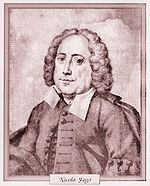Nicola Fago

Francesco Nicola Fago, 'II Tarantino' (26 February 1677 – 18 February 1745) was an Italian Baroque composer and teacher. He was the father of Lorenzo Fago (1704-1793).[1]
Biography
This section needs additional citations for verification. (December 2016) |
Born in Taranto, in the Apulia region, he studied music under Francesco Provenzale at the Conservatorio della Pietà dei Turchini in Naples between 1693-95.
Between 1704-08 he worked at the Conservatorio Sant'Onofrio, but from 1705-40 he was based at the Conservatorio della Pietà dei Turchini, where his pupils included Leonardo Leo, Francesco Feo, Giuseppe de Majo, Niccolo Jommelli, Nicola Sala, Michele de Falco, Carmine Giordani as well as his own son, Lorenzo. See: List of music students by teacher: C to F#Nicola Fago.
From 1709-31, Nicola Fago served at the Tesoro di San Gennaro. He died in Naples in 1745.[citation needed]
Operas
- Lo Masiello
- L'Astratto (1709)
- Il Radamista (1707)
- La Dafne
- Cassandra Indovina (1711)
- "Magnificat" ten vocals + instruments
- "Stabat Mater" 4 vocals + a quartet
- Il Faraone Sommerso (1709)
Other works
- Le fenzejune abbendurate, Commedia per musica, 1710
- La Cianna, Commedia per musica, 1711
- Lo Masillo Dramma per musica (second act by Michele de Falco), 1712
- La Dafne, Favola pastorale in stile arcadio, 1714
References
- ^ Companion to baroque music Julie Anne Sadie - 1991 "Fago. Neapolitan father and son who were composers and teachers. Francesco Nicola Fago (1677- 1745), known as 'II Tarantino', studied with Provenzale at the Neapolitan Conservatorio S Maria della Pieta dei Turchini, where he himself ...Francesco Nicola's first post was as primo maestro of the Conservatorio di S Onofrio (1704-8), but from 1705 he was based at the Turchini where his pupils included Falco, Feo, Majo, Leo and Jommelli, as well as his own son Lorenzo.
